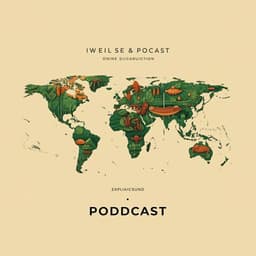
Sociology
Duration of agriculture and distance from the steppe predict the evolution of large-scale human societies in Afro-Eurasia
T. E. Currie, P. Turchin, et al.
Explore the intricate dynamics of large, complex human societies in Afro-Eurasia as investigated by Thomas E. Currie, Peter Turchin, Edward Turner, and Sergey Gavrilets. Discover how agriculture and proximity to the Eurasian steppe influenced societal organization over 3000 years, challenging conventional views on agricultural productivity.
~3 min • Beginner • English
Introduction
The study addresses why large, complex human societies (macro-states/empires) emerged more readily in some regions of Afro-Eurasia than others over the last several millennia. Drawing on cultural evolutionary theory (CET), the authors frame alternative hypotheses about selection (benefits/costs of large-scale organization), variation (generation and accumulation of institutions and norms), and inheritance (transmission across time and space). Key hypothesized drivers include: (1) steppe warfare intensity—proximity to the Eurasian steppe as a proxy for exposure to horse-based military technologies and intensified intergroup competition selecting for larger political units; (2) duration of agriculture—longer histories of agriculture allowing time for cultural experimentation and accumulation of institutions enabling large-scale organization; (3) agricultural productivity endowment—regions with higher potential productivity being more conducive to supporting complex polities; plus controls for (4) terrain ruggedness reducing conquerability, and (5) proximity to the earliest large empires (historical contingency/diffusion). The research aims to systematically test these competing/complementary hypotheses within a spatially explicit statistical framework using historical data on the distribution of large polities over 1500 BCE–1500 CE.
Literature Review
The introduction situates the debate within interdisciplinary scholarship on the evolution of sociopolitical complexity. Prior work has highlighted the roles of agriculture (both duration and productivity), information processing and technology, warfare, continental geography, and religion. The steppe warfare mechanism was previously explored via an agent-based model reproducing historical distributions of large-scale societies, but without systematic comparison to alternative hypotheses. The authors draw on CET to integrate and contrast these ideas, emphasizing processes of selection via intergroup competition, and the gradual accumulation and transmission of institutions solving large-scale collective action problems. References include Diamond (geography and agriculture), Turchin et al. (warfare and social complexity), Johnson and Earle (economic foundations of political specialists), and others addressing inequality, institutional evolution, and diffusion.
Methodology
Design: Spatially explicit statistical analysis of Afro-Eurasia using 100 km × 100 km equal-area grid cells (10,000 km²). Analyses constrained to cells where agriculture was practiced by 1500 CE and where potential agricultural production > 0.
Dependent variable: Imperial density—the frequency with which each grid cell was occupied by a polity ≥100,000 km² across time slices sampled every 100 years from 1500 BCE to 1500 CE. Polity extents were digitized from historical atlases; smaller polities were excluded (threshold varied in SI robustness checks at 80,000 and 120,000 km²). Imperial density aggregates occupancy over the 3,000-year span.
Predictors:
- Distance from the Eurasian steppe: Great-circle distance from steppe ecoregions (WWF terrestrial ecoregions), using two classifications to capture uncertainty: minimal and maximal extents (including or excluding Levant/Kyrgyzstan). Computed in R (geosphere).
- Duration of agriculture: Time since agriculture became a major dietary component, compiled from archaeological sources. Three versions: best estimate, minimum, and maximum, with the main analyses using the average of these to address uncertainty.
- Potential agricultural productivity: FAO GAEZ v3 data on maximum potential yields of main carbohydrate staple crops under baseline climate (1961–1990), used as a proxy for natural productivity endowment rather than achieved production.
- Terrain ruggedness: Standard deviation of elevation within each cell from GTOPO30 (30 arc-second resolution) as a measure of unevenness.
- Distance from first empires: Great-circle distance from regions with empires >100,000 km² at 1500 BCE, used as a control for historical contingency/diffusion.
Statistical analyses: Conducted in R 3.6.3. Initial Pearson and Spearman correlations assessed bivariate associations and collinearity. Main tests used spatial generalized least squares (GLS) via a modified nlme package, incorporating spatial structure with longitude and latitude as random control variables and great-circle distances. Due to memory intensity, models were run on multiple random sub-samples (20 samples of 1,000 cells each) to assess stability. All variables were standardized (scaled) to obtain comparable coefficients. Model selection used AIC, comparing alternative combinations of predictors and an interaction term between duration of agriculture and distance from steppe. Because likelihoods vary across subsamples, ΔAIC was used for comparability.
Temporal dynamics: Sliding 1,000-year windows (e.g., 1500–600 BCE, then 1400–500 BCE, ... to 600–1500 CE) were analyzed with the full predictor set (with and without distance from first empires), removing cells lacking agriculture by the end of each window. Each window was estimated on 10 random samples of 700 cells. Additional confirmatory robustness checks addressed uncertainty in predictor constructions and alternative spatial methods; exploratory analyses examined ecological/cultural similarity effects (reported in SI).
Key Findings
- Correlations: Imperial density was positively associated with shorter distance to the steppe and longer duration of agriculture; weak association with terrain ruggedness (slightly positive, opposite to the ruggedness hypothesis); essentially no association with potential agricultural productivity. Distance from first empires correlated strongly with imperial density, and predictors showed substantial intercorrelations.
- Best-fitting models: Spatial GLS model selection favored models including duration of agriculture, distance from the steppe, and their positive interaction. Models adding agricultural productivity and terrain ruggedness did not improve fit materially; their standardized coefficients were indistinguishable from zero.
- Effect sizes and fit: Duration of agriculture and distance from steppe were the strongest predictors; the interaction term was also important. The best-fitting model explained approximately 58% of the variance in imperial density (pseudo-R² from regressing imperial density on GLS-predicted values). Including distance from first empires as a control increased AIC (worse fit, given added complexity) but that variable had the largest standardized coefficient (~0.34). Duration of agriculture (~0.21) and the interaction (~0.13) decreased slightly; distance from steppe’s effect diminished more but remained substantial.
- Temporal patterns: Over sliding 1,000-year windows, the predictive strength of distance from the steppe increased toward the end of the period (consistent with intensified warfare and eastern European state expansion towards the steppe). Duration of agriculture was consistently a good predictor, with a modest rise then slight decline later. The interaction term declined steadily over time. Potential productivity and elevation remained poor predictors across all periods. The influence of distance from first empires declined over time, suggesting diminishing historical contingency.
- Hypothesis tests: Supported—duration of agriculture; steppe warfare intensity; their positive interaction. Not supported—agricultural productivity endowment; terrain ruggedness (weak effect opposite predicted). Residual maps indicated over-prediction in parts of eastern Africa south of the Sahara, pockets in the Sahara/Arabian deserts, and eastern Europe; under-prediction in areas of China, Southeast Asia, and Iran, pointing to additional unmodeled factors.
Discussion
Findings support complementary roles for longer agricultural histories (allowing accumulation of institutions and norms for large-scale coordination) and intensified intergroup competition from steppe warfare (selecting for larger polities). The positive interaction indicates selection pressures are more effective where institutional variation has had time to develop. These effects persist even when controlling for proximity to initial large empires, suggesting they are not merely artifacts of historical contingency or diffusion from early centers. Lack of support for the productivity endowment and terrain ruggedness hypotheses suggests that beyond a basic agricultural productivity threshold, natural endowment alone did not make large-scale societies more likely, and ruggedness did not systematically hinder empire formation at this scale.
The results underscore probabilistic, non-deterministic dynamics: the best model explains over half of variance, leaving considerable unexplained variation due to measurement limits, coarse proxies, and omitted factors. Residual patterns point to additional influences such as resource distributions and appropriability, trade and connectivity, and ecological/cultural similarity shaping diffusion and viability of institutions. The CET framework helps synthesize these processes, viewing large-scale social organization as products of selection on culturally transmitted institutions interacting with geography and ecology.
Generalization beyond Afro-Eurasia and 1500 BCE–1500 CE requires caution. Horse-based warfare was absent in the pre-contact Americas and declined in importance after 1500 CE with firearms and naval power; alternative proxies for competition would be needed. Nonetheless, duration of agriculture likely remains relevant in other regions (e.g., early domestication centers in the Americas). Achieved, not just potential, agricultural productivity is important for sustaining complex societies, but it is endogenous to technological and institutional development; future time-series data could clarify reciprocal causality.
Conclusion
The study provides empirical support for two key determinants of where and when large, complex societies emerged in Afro-Eurasia: longer durations of agriculture and intensified warfare associated with proximity to the Eurasian steppe, with a positive interaction between them. It rejects the view that higher natural agricultural productivity or rugged terrain primarily drove the geographic distribution of empires at this scale. By integrating alternative hypotheses within a cultural evolutionary framework and spatial statistical modeling, the paper advances understanding of how ecological and social processes jointly shaped macro-scale human organization.
Future research should: (1) extend analyses to other regions and later periods using context-appropriate proxies for intergroup competition; (2) incorporate achieved agricultural productivity and technological change via comparative time-series; (3) refine measures of warfare intensity and institutional evolution; (4) examine roles of resources, trade networks, and ecological/cultural similarity in diffusion; and (5) analyze heterogeneity in institutional inclusiveness and inequality across complex societies.
Limitations
- Proxy measures and coarse resolution: Warfare intensity proxied by distance from the steppe; potential (not achieved) agricultural productivity; grid cells of 10,000 km² may mask local variation. Measurement error and uncertainty in agricultural onset dates handled via min/max/best estimates but remain imperfect.
- Outcome construction: Imperial density aggregates presence of polities ≥100,000 km² at 100-year intervals; size threshold choices and temporal sampling may affect results (tested in SI robustness checks).
- Spatial modeling constraints: Memory-intensive GLS led to analysis on random subsamples, which could introduce sampling variability (mitigated by replication across many subsamples). Spatial structure addressed via nlme with great-circle distances, but alternative specifications may yield differences.
- Control variable overlap: Distance from first empires is partly derived from the same historical sources as the dependent variable, complicating causal interpretation though used conservatively.
- Scope and external validity: Focus limited to Afro-Eurasia, 1500 BCE–1500 CE; mechanisms like horse-based warfare may not generalize to other regions/periods without alternative proxies.
- Omitted variables: Residual patterns suggest unmodeled factors (e.g., resource appropriability, trade connectivity, cultural/ecological similarity) likely contribute to variation.
Related Publications
Explore these studies to deepen your understanding of the subject.







